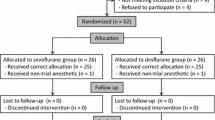Abstract
The aim of the study was to compare recovery characteristics in adult patients following general anaesthesia either with the new investigational volatile agent sevoflurane or with propofol. Accordingly, two groups of 25 adults undergoing outpatient surgery were entered into a prospective, randomised study. Patients who received sevoflurane were extubated at an earlier stage than those receiving propofol (6.6 vs. 9.8 min), and the times to eye opening (7.2 vs. 12.6 min) and hand squeezing (8.2 vs 13.8 min) were also shorter. As measured by the digit-symbol substitution test, patients regained the pre-operative level of cognitive function significantly earlier after sevoflurane anaesthesia. Modified Aldrete scores were also higher in this group within the first hour after anaesthesia than in the propofol group. Sevoflurane appears to be a useful alternative to propofol in outpatient anaesthesia.
Similar content being viewed by others
References
Frink EJ, Malan TP, Atlas M, Dominguez LM, DiNardo JA, Brown BR (1992) Clinical comparison of sevoflurane and isoflurane in healthy patients. Anesth Analg 74:241–245
Smith I, Ding Y, White PF (1992) Comparison of induction, maintenance, and recovery characteristics of sevoflurane-N2O and propofol-sevolfurane-N2O with propofol-isoflurane-N2O anaesthesia. Anesth Analg 74:253–259
Naito Y, Tamai S, Shingu K, Fujimori R, Mori K (1991) Comparison between sevoflurane and halothane for paediatric ambulatory anaesthesia. Br J Anaesth 67:387–389
Aldrete JA, Kroulik D (1970) A postanaesthetic recovery score. Anesth Analg 49:924–934
Randel GI, Levy L, Kothary SP, Pandit SK (1992) Propofol versus thiamylal-enflurane anesthesia for outpatient laparoscopy. J Clin Anesth 4:185–189
Millar JM, Jewkes CF (1988) Recovery and morbidity after daycase anaesthesia. Anaesthesia 43:738–743
Korttila K, Östman P, Faure E, Apfelbaum JL, Prunskis J, Ekdawi M, Roizen MF (1990) Randomized comparison of recovery after propofol-nitrous oxide versus thiopentone-isoflurane-nitrous oxide anaesthesia in patients undergoing ambulatory surgery. Acta Anaesthesiol Scand 34:400–403
Youngberg JA, Texidor MS, Smith DE (1987) A comparison of induction and maintenance of anesthesia with propofol to induction with thiopental and maintenance with isoflurane. Anesth Analg 66:S191
Van Doze A, Shafer A, White PF (1988) Propofol-nitrous oxide versus thiopental-isoflurane-nitrous oxide for general anesthesia. Anesthesiology 69:63–71
Rapp SE, Conahan TJ, Pavlin J, Levy WJ, Hautman B, Lecky J, Luke J, Nessly ML (1992) Comparison of desflurane with propofol in outpatients undergoing peripheral orthopedic surgery. Anesth Analg 75:572–579
Wrigley SR, Fairfield JE, Jones RM, Black AE (1991) Induction and recovery characteristics of desflurane in day case patients: A comparison with propofol. Anaesthesia 46:615–622
Fredman B, Nathanson MH, Wang J, Klein K, White PF (1994) Use of sevoflurane vs propofol for outpatient anesthesia: Recovery profiles. Anesth Analg 78:S121
Korttila K, Faure E, Apfelbaum J, Östman P, Roizen M (1988) Less nausea and vomiting after propofol than after enflurane or isoflurane anesthesia. Anesthesiolog 69:A578
McCollum JSC, Milligan KR, Dundee JW (1988): The antiemetic action of propofol. Anaesthesia 43:239–240
Kazama T, Ikeda K (1988) The comparative cardiovascular effects of sevoflurane with halothane and isoflurane. J Anesth 2:63–68
Holaday DA, Smith FR (1981) Clinical characteristics and biotransformation of sevoflurane in healthy human volunteers. Anesthesiology 54:100–106
Author information
Authors and Affiliations
Rights and permissions
About this article
Cite this article
Wandel, C., Neff, S., Böhrer, H. et al. Recovery characteristics following anaesthesia with sevoflurane or propofol in adults undergoing out-patient surgery. Eur J Clin Pharmacol 48, 185–188 (1995). https://doi.org/10.1007/BF00198296
Received:
Accepted:
Issue Date:
DOI: https://doi.org/10.1007/BF00198296




